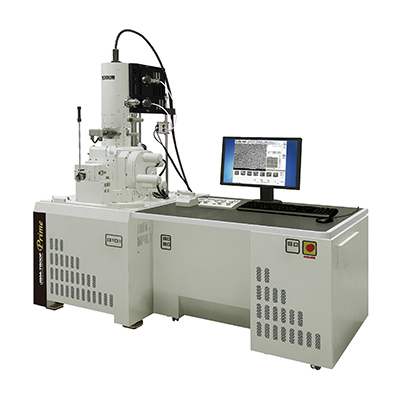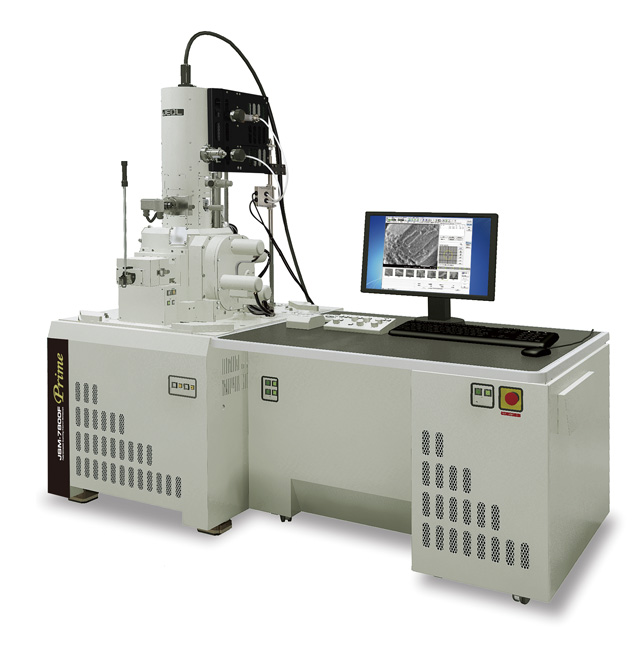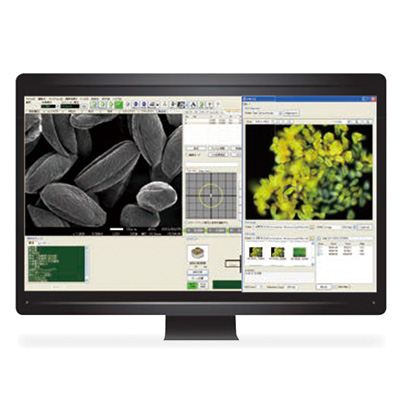【DISCONTINUED】JSM-7800FPRIME Schottky Field Emission Scanning Electron Microscope
DISCONTINUED

This product is no longer available.
If you would like to know the latest information about your preferred product or to find out more about alternatives, please click on the link below. We hope you will continue to use our products.
Features
JSM-7800FPRIME delivers the world's best resolution with the incorporation of the newly-developed, super-high resolution Gentle Beam (GBSH). In addition, the maximum probe current of the In-lens Schottky Plus gun has been increased from 200 nA to 500 nA.
In-Lens Schottky Plus Field Emission Electron Gun
Higher brightness is achieved by optimizing the combination of the electron gun and low aberration condenser lens. Probe currents of a few pA to several tens of nA are obtained even with a low accelerating voltage by efficiently collecting the electrons generated by the gun, making it possible to perform high resolution observation as well as high-speed element mapping and EBSD on the nano-scale, while maintaining the smallest objective aperture.
Surface observation using GBSH (Gentle Beam Super High Resolution)
The existing *Gentle Beam (GB) has been improved to apply even higher voltages to the specimen, providing super-high resolution images with low accelerating voltages. GBSH allows you to select the accelerating voltage best suited to the application, from specimen surface observation to nano-scale element analysis.
Gentle Beam(GB) is a technique of applying a bias voltage to the specimen to reduce the speed of the incident electrons, and accelerate the speed of the emitted electrons.
Top surface imaging using Gentle Beam
By applying a bias voltage to the specimen (GB), the speed of the incident electrons is reduced and the speed of the released electrons is increased. This allows high-resolution images with a good signal-to-noise ratio to be acquired even with low specimen landing voltage. If GBSH mode is used, which allows a higher bias voltage to be applied, higher-resolution observations can be made even at landing voltages of just a few tens of eV.
Acquisition of all information using multiple detectors
The JSM-7800F incorporates 4 types of detectors, including an upper electron detector (UED), upper secondary electron detector (USD), backscattered electron detector (BED), and a lower electron detector (LED). For the UED, the secondary electron and backscattered electron collection can be changed according to the filter voltage, making it possible to select the electron energy for image acquisition. The USD detects the low-energy electrons that are rejected by the filter grid. With the BED, channeling contrast –contrast can be clearly observed by detecting either high or low-angle backscattered electrons. The LED enables acquisition of images with a 3-dimensional appearance, including the surface roughness information from the illumination effects.
Specifications
| Resolution | 0.7 nm(15 kV)
0.7 nm(1 kV) 3.0 nm (5 kV、WD10 mm、5 nA) |
|---|---|
| Magnification | x25 to x1,000,000(SEM) |
| Accelerting Voltage | 0.01 kV to 30 kV |
| Probe current | Several pA to 500nA |
| Aperture angle optimizing lens | Built-in |
| Detectors | Upper Electron Detector(UED)
Lower Electron Detector(LED) |
| Energy filter | UED Filter Voltage Change Function built-in |
| Gentle beam | Built-in |
| Image display | Image display area 1,280 x 960 pixel, 800 x 600 pixel |
| Specimen exchange chamber | Standard
Specimen Exchange Chamber TYPE2A |
| Specimen stage | 5-axis motor drive stage
Full eucentric goniometer stage |
| X-Y | X:70mm, Y:50mm |
| Tilt | -5 to +70° |
| Rotation | 360° |
| WD | 2 mm to 25 mm |
| Evacuation system | Two SIPs, TMP, RP |
| Eco design | During normal operation :1.1 kVA
During the sleepmode : 0.8 kVA |
Principal Options
Energy Dispersive X-ray Spectrometer (EDS)
Wavelength Dispersive X-ray Spectrometer (WDS)
Electron Backscatter Diffraction (EBSD) System
Cathodoluminescence Detector (CLD)
Application
Application JSM-7800FPRIME
Application of Scanning Electron Microscope to Dislocation Imaging in Steel
High Angle Backscattered Electrons and Low Angle Backscattered Electrons
Rapid Characterization of Bacteria Using ClairScope and SpiralTOF
Gallery

Related Products

miXcroscopy™ Linked Optical & Scanning Electron Microscopy System
The same specimen holder can now be used for both the optical microscope and the scanning electron microscope. As a result, by managing the stage information with dedicated software, it is possible for the system to record the locations observed with the optical microscope, and then further magnify the same areas with the scanning electron microscope to observe the fine structures at higher magnification & higher resolution.The observation targets found with the optical microscope can be seamlessly observed with the scanning electron microscope without having to search for the target again. It is now possible to smoothly and easily compare and verify the optical microscope images and scanning electron microscope images.
More Info
Are you a medical professional or personnel engaged in medical care?
No
Please be reminded that these pages are not intended to provide the general public with information about the products.
